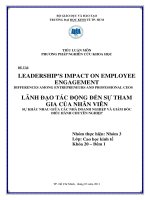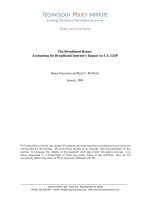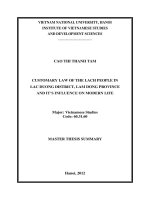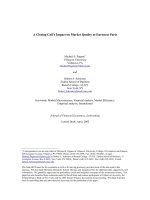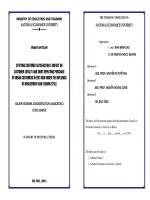INDUSTRY 4 0 AND IT’S IMPACT ON LOGISTIC PROCESS IN UPS COMPANY managing operations and the supply chain
Bạn đang xem bản rút gọn của tài liệu. Xem và tải ngay bản đầy đủ của tài liệu tại đây (108.57 KB, 10 trang )
Student Name:
NGO THI HONG TRUC
Student ID:
17453180
BSOM046
Title of Module:
Managing Operations and the Supply
Assignment 1:
INDUSTRY 4.0 AND IT’S IMPACT ON LOGISTIC PROCESS IN UPS
COMPANY
Lecturer Name:
Andrew Gough
Submission Date:
2018/06/01
1|Page
Contents
2|Page
1) Introduction
UPS – United Parcel Service – is a global company was found in 1907 in the United States
which supplies package delivery, specialized transportation and logistics services. After more
than a century operating, UPS widen its business in over 200 countries and territories all
around the world, managed the flow of goods, funds and informations. According to 2017
Forbes Global 2017 ranking of the Wolrd’s largest transportation companies, UPS continued
leading the top position which earned $61 billions in annual revenues getting from steady
domestic and international growth in e-commerce trading. (Forbes, 2017)
UPS provides a powerful competitive advantage using advanced technology, integrated
network of physical, technological, and global resources aims to meet their customer’s need
and grow their business. UPS has significantly expanded its capabilities scopes primarily
through industry leaders in retail shipping and business services, customs brokerage,
trucking and air freight, finance and international trade service. As the result, UPS’s
customer relationships have deepened to include much more than basic transportation
service.
Mostly taking advantage from Information and communication technologies in business
process, UPS has formed a smart system which provide the best efficient service to
customer in reducing cost and time of distribution and logistic progress. This application
would be the result of the concept of Industry 4.0, which might require technological changes
in integrity control and transparency in supply chain. This paper tries to shed some light to
debate about Industry 4.0 and its impact in logistic industry, as well as how it changed UPS
company while doing business in this era of technology.
3|Page
2) Literature review
Industry 4.0
Industry 4.0 is the result of the Fourth Industrial revolution, which been developed from the
first three revolution in the past (Kagermann et al., 2013). The first revolution occurred from
18th to 19th century with the development of the steam engine and industry of mechanization.
The second one is the period of using electricity, the conveyor belt and assembly line to
create mass production. This revolution took place before World war I (from 1870 to 1914).
The third revolution refer to the massive use of electromics and advancement of information
and communication technology which occurred from 1980s on going. The emergence of
cyber technologies in various field such as robotics, artifical intelligence, nanotechnology,
quantum computing and biotechnology has contributed the Fourth industrial revolution
(Natalia Szozda, 2015). Mainly characterized by advance in technology, “Industry 4.0”
connect more and more people to the web, develop the efficiency of business and
regenerate the natural environment through better asset management (Klaus Schwab,
2017). Simply way to explain this term is a revised approach to manufacturing that the latest
technological inventions and innovations was used (Moeuf et al., 2017)
Industry 4.0 has strong impact on two main fields, one is factories and other is distribution
and procurement (Natalia Szozda, 2015). Fully automated company, mass personalization of
production and e-factories are the three possible archetypes which be applied from Factory
4.0. Manufacturing company would be allowed to react faster to change demand in
production volumes and diversity of their product through flexible production equipment and
automation technology. In the result, optimize their customer’s business and gain vast new
potential customer. The emergence of digital manufacturing was named as “Smart factory” –
is the application of information technologies including Internet of Thing, big data, cloud
computing and artificial intelligence technologies (Shiyong et al., 2016).
Logistic 4.0
Due to limitation of discussion, this paper strongly focuses on the application of Industry 4.0
on logistic, which was definitely affected by Cyber-physical systems (CPS). CPS sets up an
intelligent and autonomous system by using computing, communications and control
(Danda, 2016). This might contribute to the development of several new applications such as
production processes, healthcare service, autonomous vehicles, transportation system,
logistics services. Logistic would be the most important application of Industry 4.0 while it
takes many advantages from the development of technology in term of improving the speed
and security of logistic process, which was known as “Internet of Things” (IoT). IoT has
become a worldwide trend with applications across al industrial sectors in developing and
intergrating the related technologies (Amy J. C. Trappey, 2017). In addition, IoT also provide
4|Page
and better communication and cooperation in a more effective way and cost-efficient manner
of service provision and logistics by shortened production cycles, safety and security and
automatically maintenance (Macaulay, J., 2015).
“Smart logistic” is defined as the technology driven approach of “Smart products” and “Smart
services” which can perform tasks that normally performed by people (Uckelmann D, 2008).
“Smart logistic” helps to improve the level of customer service, the optimization of the
production and make lower prices of storage by enhancing the flexibility and the adjustment
to the market changes. But the weakness of Smart logistic is the high dependency on the
technology, which means it must to change accordingly to the actual technology driven.
Example is given to clarify how technology work on logistic process. Before the appearance
of Internet, logistics is controled by simple transport process. But now, all the data is
collected in mordern system and well-organized by Internet. All the information is generated
for enterprises and carriers which are used in the real time. Everyone would find it easy to
place a booking and track their goods’s delivery status since all the datas associated with
physical object can be collected and monitored efficiently. Meanwhile, every information is
clear to avoid any mistake and delay in delivery process, ensure the best service to end-toend customer.
There are five technological implementations of Logistic 4.0.
Firstly, Resource Planning would be more effective in term of increase the productivity by
CPS implemetating. On the other hand, visibility and adequate forecast will substantially
enhance which optimize the degree of specialization of human resources.
Next, Warehouse systems easily be well-managed since the right location and arrival time of
goods have been setted up by CPS. The entire supply chain can prevent unnecessary cost,
meanwhile save the operating cost in warehouse management.
Apply GPS technology, Transportation Management systems can locate exactly where to
ship the goods to, reduce the time and eliminate the mistake in delivery process. Every data
will be collected into system and give an effective way to tracking transportation information.
Intelligent transportation system provides the cooperation platform for transport and
navigation systems. It plays a main role in enhancing the safety, security, and reduce traffic
risks. For environment, it also gives a hand in reducing the carbon emissions and air
polution.
Finally, in this IoT era, all information need to be strongly secured when doing business,
especially in logistic industy. Information security develops the ability to protect the
information asset and IT infrastructure.
5|Page
3) Summary synthesis
The main business of UPS is giving supply chain solution including logistic and distribution,
transportation and freight (air, ground, sail); freight forwarding to nearly 200 countries and
territories; international trade management; and custom brokerage. Further to key services,
UPS also provide specialty services such as service parts logistics, technical repair and
configuration; supply chain design and planning, return management.
UPS offer IT technogy application called API - Application Programming Interfaces - are
programming instructions and standards allowing customer to access and integrate UPS
functionality directly into enterprise system and website. These advance technologies are
designed to maximum flexibility for their customers during integrating process. By integrating
UPS transportation functionality like Rating, Shipping or Tracking directly into customer’s
business system, it makes the user experience an efficient and save-cost process in delivery
and shipping term.
Whether it’s making logistic processes faster for customer or giving online shoppers
information they need to make the decisions, API smooth the way without any toggling
between customers’s systems. API can help boost both productivity and sale by incorporate
functionality.
There are various functions provided by API.
The first one is The Address Validation which can check a customer’s address. Whenever
discovered an error, it provides suggested alternatives to customer for easy checking. This
function can help to catch errors before they catch up with customer, meanwhile reduce
operating costs and improve customer service.
Secondly, Rating API lets customer compare the cost, rate them and select shipping service
based on their need and budget. Some customers want their packages right away who can
choose express services or other choose standard services when they have more time for
delivery to save cost. No hiden information exist while customer can know the exact
schedule their package will arrive, how much shipping will cost and whether it is the best
price or not.
Next, API can provide consistent, up-to-date shipping information based on the origin and
destination addresses and the date the shipment is needed by Time in Transit function. API
6|Page
may help customer control their inventory when receiving the merchandise as well as
synchronise the arrival of multiple package with different origin.
Getting close to company’s business needs, Shipping API customise the delivery into
isystem without any addition of expensive hardware or software. Creating greater
efficiencies in the mailroom to lower overall costs and implement better controls over
shipping activities.
The API Tracking let online shopper track their shipment right from e-commerce site using
customer’s reference or order number. They return to customer site to track their shipment
status, in the meantime, blend seamlessly with the look of site. By offering end-to-end
tracking order service, customers also lengthen the amount of time spending on their
website and drive additional traffic.
The UPS TradeAbility API works with customer’s business applications seamlessly once
intergrated to give the information and services managing international trade processes. All
the information regarding to latest export license requirement or any country-specific trade
relations, procedures and restriction before importing would be easily connect from a signle
web interface. This function is a suite of API which adds a new level of customer service and
functionality to their enterprise or e-commerce website.
And the most important fuction letting UPS become the most reliable logistic company in the
world is Paperless document API. Customer enables to upload customised trade documents
for customs clearance to the UPS documents repository called “Forms History”. It would
make international shipments more efficiently by linking the document image to the shipment
identification number by manifesting system. All the process could be based on Paperless
Document API upload process. Paperless document API issues the E-Invoice to customer,
which reduce the paper’s use comsumption, save the energy and reduce the pollution. This
is a sustainable development strategy based on “green technology” of UPS which create
competitive advance in logistic industry.
Higher level of interating UPS technology is Worldship which gives customer several options
for getting the information required to generate shipping labels. It would be perfect for a big
company who wants to pull complete shipment information one order at a time or as a batch.
When setting up data into and out of Worldship, it can help to streamline order entry,
customer service, accounting, procurement, and billing processes
7|Page
4) Conclusions
“Having the right product at the right time at the right place and in the right condition – these
are the well-known requiments for logistics and transportation in general” (Uckelmann
D.,2008)
The advance of technology is driving appoaches the growing operational demands and the
complexity in fulfilling customer requirement. Adaptability and proactivity would become
more and more important to achieve new technology integration. The highly demand logistic
markets and complexity of logistic networks have created the significant change from
traditional supply chains to open supply networks which require new methods, products and
services. The smart logistic provides greater accuracy and efficiency in logistic operation by
using the advantage from Internet revolution (Amy J. C. Trappey, 2017).
The evolution of Information and Communication technology in Industry 4.0 era is becoming
avoidable. Maximum applying technology in logistic and transportation, UPS offer the API
program to customise customer’s business system. Every single customer of UPS will enjoy
the depth of UPS service and capabilities, reduce operating cost, smooth the business
processes and better controls over the shipping activities. As the result, satisfying
customer’s need is one of the most important factor in building the sustainable development
of UPS in future, helping to gain more and more customers as well as profitability.
Furthermore, in this uncertainty world, everything changes fast and rapidly day by day. No
one can say that Industry 4.0 revolution is the last revolution in the world. Always be ready
for the change, company can able to catch any new technology or new revolution, adapt and
take advantage from them to maximize customer’s satisfying and keep business moving
higher.
8|Page
References
Alasdair Gilchrist (2016) Industry 4.0: The Industrial Internet of Things. Berkeley, CA: Apress
L. P.
Alexandre Moeuf, Robert Pellerin, Samir Lamouri, Simon Tamayo - Giraldo & Rodolphe
Barbaray (2017) The industrial management of SMEs in the era of Industry 4.0. International
Journal of Production Research, pp.1118-1136
Amy J. C. Trappey, Charles V. Trappey, Chin-Yuan Fan, Abby P. T. Hsu, Xuan-Kai Li & Ian J.
Y. Lee (2017) IoT patent roadmap for smart logistic service provision in the context of
Industry 4.0. Journal of the Chinese Institute of Engineers, 40:7, 593-602.
Atzori, Luigi, Antonio Iera, and Giacomo Morabito (2010) “The Internet of Things: A survey.”
Computer Networks 54 (15): 2787-2805
Danda B Rawat, Joel Rodriques, Ivan Stojmenović (2016) Cyber-physical systems: From
theory to Practice
Forbes (2017) 2017 Forbes Global 2000: The World’s Largest Transportation Companies.
Forbes Times. [online]. Available from:
[Accessed May 21, 2018]
Kagermann, H., W. Wahlster and J. Helbig, eds., (2013) Recommendations for implementing
the strategic initiative Industry 4.0: Final report of the Industries. 4.0 Working Group.
L.Barreto, A. Amaral & T. Pereira (2017) Industry 4.0 implications in logistics: an overview.
Procedia Manufacturing, Vol.13, pp.1245-1252
Klaus Schwab (2017) The fourth industrial revolution. New York: Crown Business.
Lee, Jay, Hung-An Kao, and Shanhu Yang (2014) “Service Innovation and Smart Analytics
for Industry 4.0 and Big Data Environment.” Procedia CIRP 16: 3-8.
Macaulay J., L. Buckalew, and G. Chung. (2015) Internet of things in Logistics. DHL Trend
Research and Cisco Consulting Services. [online]. Available from:
/>ngs.pdf. [Accessed May 28, 2018]
Natalia Szozda (2015) Industry 4.0 and its impact on the functioning of supply chains.
Logforum, Vol.13(4)
Rennung, Frank, Caius Tudor Luminosu, and Anca Draghici (2016) “Service Provision in the
Framework of Industry 4.0.” Procedia - Social and Behavioral Sciences 221: 372–377
Shiyong Wang, Jiafu Wan, Daqiang Zhang, Di Li, Chunhua Zhang (2016) Towards smart
factory for industry 4.0: a self-organized multi-agent system with big data based feedback
and coordination. Computer Networks, pp.158-168
9|Page
Uckelmann D. (2008) A Definition Approach to Smart Logistics. Next Generation Teletraffic
and Wired/Wireless Advanced Networking. NEW2AN 2008. Lecture Notes in Computer
Science, vol 5174. Springer, Berlin, Heidelberg.
UPS (2018) [online]. Available from: [Accessed May 21, 2018]
10 | P a g e
